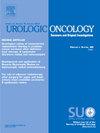Comparative outcomes of radical nephroureterectomy and kidney-sparing surgery in the treatment of high-grade upper tract urothelial carcinoma
IF 2.3
3区 医学
Q3 ONCOLOGY
Urologic Oncology-seminars and Original Investigations
Pub Date : 2025-08-13
DOI:10.1016/j.urolonc.2025.06.023
引用次数: 0
Abstract
Purpose
Upper tract urothelial carcinoma (UTUC) can be managed via radical nephroureterectomy or kidney-sparing surgery. Unfortunately, there is a paucity of data comparing radical vs. kidney-sparing management for high-grade UTUC. This study compares outcomes of radical nephroureterectomy to kidney-sparing surgery for high-grade UTUC.
Materials and methods
We retrospectively reviewed all patients with > 1-year follow-up treated for high-grade UTUC at our institution from 2015 to 2021. Oncologic and clinical outcomes were recorded. Procedure-related burden was analyzed as total procedures under anesthesia, anesthesia time, days hospitalized, and estimated cost of care.
Results
We identified 47 patients treated with radical nephroureterectomy and 16 with kidney-sparing surgery, including 1 managed via segmental ureterectomy, 14 with ureteroscopy and ablation, and 1 percutaneously. Survival outcomes, including 5-year overall survival, 3-year metastasis-free survival, and 3-year recurrence-free survival, were similar between cohorts. Patients managed with radical nephroureterectomy experienced fewer procedures but more severe perioperative complications than those treated with kidney-sparing surgery –2.1 ± 1.7 procedures vs. 3.3 ± 1.8 procedures (P = 0.037) and 0.4 ± 0.6 vs. 0 severe complications per patient, respectively (P = 0.047). Total anesthesia time and days hospitalized for radical nephroureterectomy were similar to kidney-sparing surgery at 477 ± 184 minutes vs. 377 ± 216 minutes (P = 0.13) and 6.7 ± 4.5 days vs. 5.5 ± 4.6 days, respectively (P = 0.36). Patients treated with radical nephroureterectomy experienced a greater median in-network cost of care than kidney-sparing surgery at $9,257 (IQR $7,386–$12,550) vs. $5,789 (IQR $4,833–$7,069), respectively (P = 0.009). Average changes in GFR were −21.1 mL/min/1.73 m² and -6.8 mL/min/1.73 m² for radical nephroureterectomy and kidney-sparing surgery, respectively (P = 0.11). At 2 years after surgery, 97.1% of patients who underwent radical nephroureterectomy and 100.0% who underwent kidney-sparing surgery experienced a GFR decline < 10 mL/min/1.73 m² (P = 0.12).
Conclusion
Oncologic and clinical outcomes were similar in this select cohort of patients with high-grade UTUC treated with kidney-sparing surgery or radical nephroureterectomy. Patients treated with kidney-sparing surgery endured a greater procedural load than radical nephroureterectomy but at reduced in-network cost and with fewer severe complications. Larger datasets are needed to further evaluate outcomes and treatment burdens of radical nephroureterectomy vs. kidney-sparing surgery as high-grade UTUC treatment.
根治性肾输尿管切除术与保留肾脏手术治疗高级别上尿路上皮癌的比较结果。
目的:上尿路上皮癌(UTUC)可通过根治性肾输尿管切除术或保肾手术治疗。不幸的是,对于高级别UTUC,比较根治性治疗和保留肾脏治疗的数据缺乏。本研究比较了根治性肾输尿管切除术与保肾手术治疗高级别UTUC的结果。材料和方法:我们回顾性分析了2015年至2021年在我院接受高级别UTUC治疗的所有患者,随访1年。记录肿瘤和临床结果。手术相关负担分析为麻醉下的总手术数、麻醉时间、住院天数和估计护理费用。结果:47例患者行根治性肾输尿管切除术,16例行保肾手术,其中1例行输尿管节段切除术,14例行输尿管镜及消融术,1例经皮穿刺。生存结果,包括5年总生存期、3年无转移生存期和3年无复发生存期,在队列之间相似。根治性肾输尿管切除术患者的手术次数少于保留肾脏手术患者,但围手术期并发症更严重,分别为2.1±1.7例对3.3±1.8例(P = 0.037)和0.4±0.6例对0例严重并发症(P = 0.047)。根治性肾输尿管切除术的总麻醉时间和住院天数与保肾手术相似,分别为477±184分钟比377±216分钟(P = 0.13)和6.7±4.5天比5.5±4.6天(P = 0.36)。接受根治性肾输尿管切除术的患者的网络内护理费用中位数高于保留肾脏手术,分别为9,257美元(IQR $7,386- 12,550美元)和5,789美元(IQR $4,833- 7,069美元)(P = 0.009)。根治性肾输尿管切除术和保肾手术的GFR平均变化分别为-21.1 mL/min/1.73 m2和-6.8 mL/min/1.73 m2 (P = 0.11)。术后2年,97.1%行根治性肾输尿管切除术的患者和100.0%行保肾手术的患者GFR下降< 10 mL/min/1.73 m²(P = 0.12)。结论:采用保肾手术或根治性肾输尿管切除术治疗的高级别UTUC患者的肿瘤学和临床结果相似。与根治性肾输尿管切除术相比,接受保肾手术的患者承受了更大的手术负担,但网络内成本更低,严重并发症更少。需要更大的数据集来进一步评估根治性肾输尿管切除术与保留肾脏手术作为高级别UTUC治疗的结果和治疗负担。
本文章由计算机程序翻译,如有差异,请以英文原文为准。
求助全文
约1分钟内获得全文
求助全文
来源期刊
CiteScore
4.80
自引率
3.70%
发文量
297
审稿时长
7.6 weeks
期刊介绍:
Urologic Oncology: Seminars and Original Investigations is the official journal of the Society of Urologic Oncology. The journal publishes practical, timely, and relevant clinical and basic science research articles which address any aspect of urologic oncology. Each issue comprises original research, news and topics, survey articles providing short commentaries on other important articles in the urologic oncology literature, and reviews including an in-depth Seminar examining a specific clinical dilemma. The journal periodically publishes supplement issues devoted to areas of current interest to the urologic oncology community. Articles published are of interest to researchers and the clinicians involved in the practice of urologic oncology including urologists, oncologists, and radiologists.

 求助内容:
求助内容: 应助结果提醒方式:
应助结果提醒方式:


